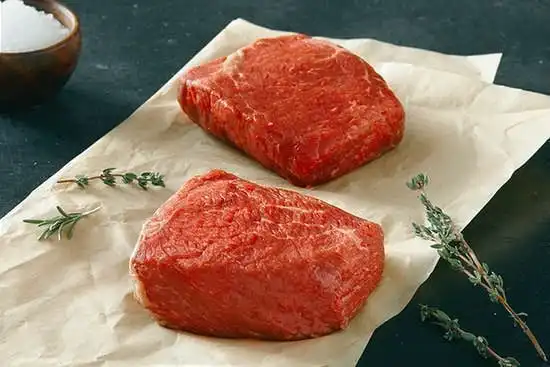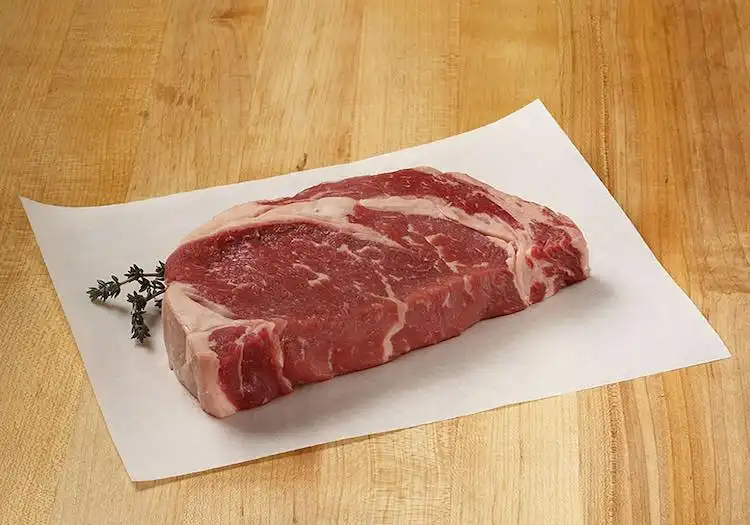Which Is Better? Ribeye vs Sirloin Steak

Ribeye and sirloin are some of the most well-known cuts of steak, but a recognizable name doesn’t tell you much about their differences or how to prepare them.
That’s where we come in.
We’ll be breaking down what sets these two amazing cuts of beef apart and showing you specific ways to prepare them to help you get the best from your steak.
What is a ribeye steak?
As you might guess from the name, the ribeye is taken from rib primal, specifically from ribs six through twelve.
The ribeye is held up as one of the best steaks you can buy as it combines a healthy dose of marbling with a large fillet of the tender longissimus dorsi muscle.

The intramuscular fat that makes up the marbling helps keep the meat moist during cooking and enhances its flavor. Because the longissimus dorsi muscle doesn’t see much use during the animal’s life, it remains tender and has a deep beefy flavor.
Most ribeye steaks also come with a characteristic cap of the spinalis muscle, which is separated from the longissimus dorsi by a kernel of fat.
The spinalis is heavily marbled and adds a rich, juicy, and flavorful element that, on its own, would be too fatty, but combines fantastically with the leaner meat of the rest of the cut.
Ribeyes can be bought with or without the bone. The bone-in ribeye is commonly referred to as a cowboy steak, or tomahawk steak when the full length of the bone is left on.
And you might find the ribeye advertised as a Delmonico, Spencer, beauty steak, or a Scotch fillet.
What is a sirloin steak?
The sirloin is a larger subprimal cut that is often separated into a variety of other cuts, including roasts, the T-bone steak, and the top sirloin, which is the most common sirloin steak cut.
Compared to ribeye, sirloin is a much leaner cut of meat. It lacks the distinctive marbling and fatty cap of the ribeye, which means it isn’t as heavily flavored or as tender.

Trimmed of fat and connective tissue, sirloin steak is still packed with beefy flavor and has a characteristic chew without being tough. If you want a deeper flavor in your sirloin, then opt for a steak that has been dry-aged for at least 21-days.
Sirloin is an excellent choice if you want a tender and flavorsome steak without the ribeye’s high-fat content. You can sometimes find sirloin steaks advertised as New York Strip, Kansas City Strip, Omaha Strip, or a club steak.
Which is better – Ribeye or Sirloin?
Calling a specific steak cut “better” than another one is obviously a heavily subjective choice. However, if you’re struggling to choose between the ribeye and the sirloin, there are some key areas you can use to draw a comparison:
Flavour and appearance
The depth of flavor associated with a specific steak cut is in direct proportion to the amount of fat it contains. Ribeye has significantly more marbling than sirloin steak and the fatty spinalis cap that increases the depth of its flavor.

However, as we mentioned, dry-aging is a common technique used to increase the tenderness and flavor of beef steaks. So, if you want a rich beefy taste but don’t like fatty meat, you can always opt for a dry-aged sirloin for the best of both worlds. You can even use dry-aging bags to age your own steaks at home.
Price
There are several factors that influence the cost of a steak, including the breed of animal it comes from, its weight, and its USDA rating. However, as a general rule, the extra marbling of the ribeye means you’ll be paying more for it than a similarly sized sirloin steak.
Because the USDA rating system is based on the amount of marbling, and the ribeye is the cut used to determine the rating of the entire carcass, ribeye steaks are also more likely to be rated as ‘Prime,’ making them more expensive.
Health benefits
There are several health benefits associated with eating leaner beef and, if you are looking to reduce the fat in your diet without cutting down on your steak intake, then sirloin is a great choice.
Significantly leaner than a ribeye, top sirloin steak still retains its tenderness and taste without the intense marbling of its fattier counterpart.
Best cooking methods
While the ribeye and sirloin are both unique cuts of steak, they both are excellent choices for grilling.
For a thick ribeye or sirloin go for the reverse sear
The extra marbling and fatty cap of the ribeye make it perfect for the reverse sear method. This is where you cook the steak at low temperatures and then finish with a quick hot sear. The extra fat keeps the meat juicy and helps form a delicious crispy crust that adds to its already rich flavor.

- Use a smoker for the first part of the cook as the smoke will add extra flavor, and the low temperature allows the steak to cook nice and evenly
- When your steak is 10-15°F below your target temperature, take it off the smoker and throw it on a screaming hot grill or cast iron pan.
- If you need to take the steak off but you aren’t ready to sear yet, just warp it loosely in some aluminum foil until you are ready to grill.
Don’t sleep on the sous vide sear for sirloin
Because it lacks the fat of the ribeye, the sirloin benefits from a more delicate approach. You can definitely still cook sear it on a grill, but using a technique like sous vide allows you to cook your steak to the perfect medium-rare, without the possibility of overcooking it.
- As with the ribeye, if you have the time, prepare your steaks in advance by salting them thoroughly and leaving them uncovered in the refrigerator for around 24 hours.
- Vacuum seal your steak and cook using sous vide at 130°F for a minimum of one hour and a maximum of four hours.
- Remove the steak from its vacuum bag and leave to rest for around 10 minutes, covered, while you heat up your pan or grill. This will cool the meat and prevent it from overcooking when you sear it.
- When your pan or grill is ripping hot, pat your steak dry with paper towels and place on the cooking surface, along with a little neutral oil if you’re using a skillet.
- Cook for one minute on each side until the surface is crisp and brown.
- Serve and enjoy immediately.
Wrapping it all up
Now you know all the essential facts, you’re ready to cook up whichever cuts appeal to you most. Whether it’s the lean and tender sirloin or the rich and juicy ribeye, using our suggested cooking techniques will allow you to get the best from these excellent cuts.
Do you have a preference between sirloin and ribeye? Perhaps you got the perfect preparation techniques for one, or both, of these cuts to share with the world? We’d love to hear about it in the comments section below.









